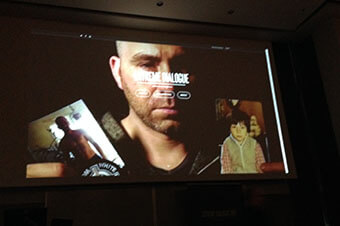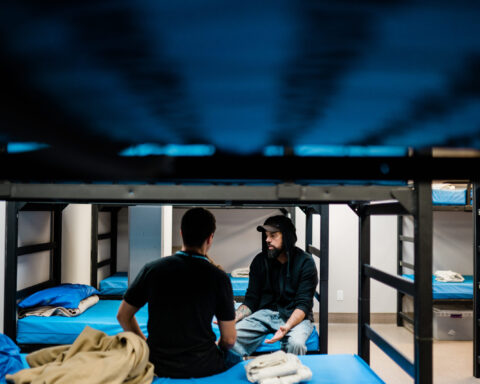Over 100 people across Canada have taken up the extremist agenda as a result of social media messages. This is according to Yvon de Champlain of the Royal Canadian Mounted Police (RCMP). And, an increasing number of Canadian youth are making headlines as victims of extremism. The Extreme Dialogue project, recently launched out of Calgary, Alberta, is working to curb this reality.
“Groups like ISIS offer as a master class in how to reach those hearts and minds. They’re using high quality product, compelling, if disgusting, imagery, and they’re going right for the jugular. They are fighting for our young people.” – Rachel Briggs, Institute for Strategic Dialogue
The school-based program, aimed at teens aged 14 to 18, consists of a series of short documentary films, which strike at the hearts and minds of our youth, by showing those profoundly affected by extremism telling their own stories, unscripted. Rachel Briggs, Senior Fellow with the Institute for Strategic Dialogue, which helped develop the project, says that, “Groups like ISIS offer as a master class in how to reach those hearts and minds. They’re using high quality product, compelling, if disgusting, imagery, and they’re going right for the jugular. They are fighting for our young people.”
Footage from the launch of the Extreme Dialogue Project in Calgary, Alberta.
The films, shot by Duckrabbit, offer raw insight into the realities of people like Christianne Boudreau, whose son Damian Clairmont died fighting with Islamic extremists in Syria in 2014, and Daniel Gallant, who spent a decade involved with white supremacist groups. Boudreau described the filming process as, “a whole week, from morning until evening, every day, round the clock, letting us tell our stories and our feelings and what we experienced as a family, how it impacted us, what’s still on our minds, what do we still have to live with, and the results of that.” Likewise, Gallant’s February 20 blog entry on his filming experience with the two members of Duckrabbit shows the deep connection made between the film subjects and the video production team. It wasn’t all doom and gloom. The result is raw and impactful.
Using Real-Life Narratives
Boudreau’s film starts with her telling us that she “never thought” she would be watching videos of Syria on the Internet, searching for her son’s face with her “nose pressed up to the screen.” She recalls how her 22-year-old son, “would talk about his passion for helping others and (question) how we could sit in our comfortable homes and do nothing.” He repeatedly verbalized these sentiments and she knew that something was off, but due to the stigma and fear surrounding subject, as well as a lack of resources, she did not get the help needed.
The film is of her and her younger son, Luke, dealing with the death of Damian together, moving through their sorrow together, even sending up messages to him in helium-filled balloons on his birthday to, “celebrate who he was in his heart and not how he died.”
The films come with accompanying educational resources to guide classroom conversation…For example, [Christianne] Boudreau’s explores topics such as ‘points of intervention’ and ‘the ripple effect’ whereas [Daniel] Gallant’s tackles ‘them and us: black and white thinking’ and ‘moving on’.
 Gallant’s film (screen shot to the left) begins with him laughing and reminiscing about joyful snapshots from his youth, from a funny haircut to dressing up for Halloween. Likewise, raw emotion is there for the viewer to read into and empathize with, as close-up shots of his face and the emotion in his eyes amplifies his account of seeing his first step-dad beat and rape his mother in front of him. And it is because the viewer is provided with a multi-hued, specific context for Gallant’s extremist involvement that it refuses this as a label and an end point for him. Instead, his story becomes something for students to discuss, interpret, and understand.
Gallant’s film (screen shot to the left) begins with him laughing and reminiscing about joyful snapshots from his youth, from a funny haircut to dressing up for Halloween. Likewise, raw emotion is there for the viewer to read into and empathize with, as close-up shots of his face and the emotion in his eyes amplifies his account of seeing his first step-dad beat and rape his mother in front of him. And it is because the viewer is provided with a multi-hued, specific context for Gallant’s extremist involvement that it refuses this as a label and an end point for him. Instead, his story becomes something for students to discuss, interpret, and understand.
The films come with accompanying educational resources to guide classroom conversation. The resource packs are extensive and specific to each film. For example, Boudreau’s explores topics such as ‘points of intervention’ and ‘the ripple effect’ whereas Gallant’s tackles ‘them and us: black and white thinking’ and ‘moving on’.
Channelling youth idealism in positive ways
Briggs of the Institute for Strategic Dialogue states that, “Extremists offer quite an exciting call to action to idealistic young people who, as we all used to do, want to right the wrongs that we see in the world around us.” The message the institute wants to convey is that: These youth are not different from us in their idealistic desire to make the world a better place, and we must find a way to harness this idealism and channel it in positive ways.
“Violent extremism can affect absolutely anybody from anywhere at any time. It just has to be that vulnerable moment when a youth gets approached… so we need to start having those hard conversations with our youth and preparing them with the tools that they need to go forward.” – Christianne Boudreau
The Extreme Dialogue project aims to help youth develop critical thinking skills in an effort to counter extremist recruitment. In the case of Boudreau, her son was depressed and withdrawn some time and when he found the religion of Islam in 2008 she was happy that he had found something positive to latch on to. He seemed, “more comfortable in his own skin,” she explains, but, “unfortunately, as he was on that path he met the wrong person at the wrong time and that’s what diverted everything,” she adds.
With extremist groups being both social media savvy and adept at staying on the right side of the law, youth cannot be shielded from extremist propaganda. What the Extreme Dialogue project’s organizers hope is youth have also encountered and engaged with strong counter-narratives to the extent that they can critically assess such messaging and turn away. As Boudreau says, “Violent extremism can affect absolutely anybody from anywhere at any time. It just has to be that vulnerable moment when a youth gets approached… so we need to start having those hard conversations with our youth and preparing them with the tools that they need to go forward.”




